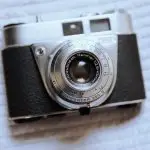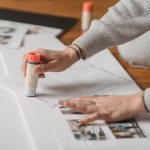Are you looking for the best glue to bond fabric and leather together? Look no further!
In this article, we will explore different types of glue suitable for fabric to leather bonding. We will also discuss important factors to consider when choosing glue for this purpose.
Additionally, we will provide you with a list of top-rated glues and a step-by-step guide for achieving a strong and durable bond.
Get ready to learn all the tips and tricks for successful fabric to leather bonding!
Table of Contents
Types of Glue for Fabric to Leather
There are several types of glue that work well for bonding fabric to leather. When choosing the best glue options, it is important to consider their adhesive strength.
One popular choice is fabric glue, which is specifically designed for bonding fabric to various surfaces, including leather. Fabric glue provides a strong bond and dries clear, making it ideal for projects where aesthetics matter.
Another option is epoxy adhesive, known for its exceptional adhesive strength. It creates a strong bond between fabric and leather, ensuring durability. Epoxy adhesive is especially useful for heavy-duty applications or when working with thicker fabrics.
Another type of glue worth considering is contact cement. This adhesive offers excellent bonding strength and is ideal for projects that require a permanent bond. It is important to note that contact cement requires proper ventilation when using due to its strong odor.
Factors to Consider When Choosing Glue
When choosing a glue for fabric to leather, it’s important to consider various factors. Choosing the right adhesive is crucial to ensure a strong and durable bond between the two materials.
One of the main factors affecting bond strength is the type of glue being used. Some adhesives, such as fabric glue or leather glue, are specifically designed for bonding these materials together. These specialized adhesives have properties that allow them to adhere well to both fabric and leather surfaces.
Another factor to consider is the drying time of the glue. Some glues dry quickly, while others require a longer drying time. It’s important to choose a glue that gives you enough time to align and position the fabric and leather before it sets.
Additionally, the flexibility of the glue is important. Fabric and leather can bend and flex, so the glue should be able to withstand these movements without cracking or breaking.
Lastly, it’s important to consider the strength of the bond. Different glues have different levels of bond strength, so it’s important to choose one that is suitable for the intended use. If you’re working on a heavy-duty project, you’ll want a glue with a strong bond that can withstand the stress and strain.
Top-Rated Glues for Fabric to Leather Bonding
When it comes to bonding fabric to leather, it’s important to choose the right type of glue that is suitable for this specific material combination.
There are various glue types available that are specifically designed for fabric to leather bonding, such as contact cement or fabric glue.
In addition to selecting the suitable glue, using long-lasting adhesive options and applying proper application techniques and tips will ensure a strong and durable bond between the two materials.
Suitable Glue Types
The best glue for fabric to leather is often a flexible adhesive like contact cement or fabric glue. These types of glue have the necessary properties to create a strong and durable bond between the two materials. When choosing a suitable glue for fabric to leather bonding, it is important to consider factors such as flexibility, strength, and compatibility with the materials. Some recommended adhesive brands for this purpose include:
| Adhesive Brand | Key Features |
|---|---|
| 3M Super 77 | Fast-drying and bonds well with different materials |
| Aleene’s Original | Flexible and durable bond |
| E6000 Craft Adhesive | Waterproof and provides a strong hold |
These adhesive brands have proven to be reliable options for bonding fabric to leather. Whether you are working on a DIY project or repairing a leather item, using the right glue can ensure a successful and long-lasting bond between fabric and leather.
Long-Lasting Adhesive Options
For a durable and lasting bond between fabric and leather, you should consider using adhesive brands like 3M Super 77, Aleene’s Original, or E6000 Craft Adhesive. These adhesives are known for their strong bonding capabilities and are commonly used in various crafting and upholstery projects.
When it comes to adhesive selection, it’s important to choose a product that is specifically designed for fabric and leather. This ensures that the adhesive will adhere well to both materials and create a strong bond that will withstand regular use and wear.
Here are three adhesive options that are known for their durability:
-
3M Super 77: This adhesive is widely used for bonding fabric and leather due to its high strength and versatility. It provides a strong bond that is resistant to heat and moisture, making it suitable for a wide range of projects.
-
Aleene’s Original: This adhesive is specially formulated for fabric and leather bonding. It dries clear and flexible, allowing the fabric to retain its natural texture and the leather to remain soft and pliable.
-
E6000 Craft Adhesive: This adhesive is known for its exceptional strength and flexibility. It forms a permanent bond that is resistant to water, chemicals, and temperature changes, making it ideal for projects that require long-lasting durability.
Application Techniques and Tips
Now that you know about the long-lasting adhesive options for fabric to leather bonding, let’s talk about some application techniques and tips.
When using the glue, make sure to clean the surfaces thoroughly to remove any dirt or oils that may hinder the bond. Apply a thin and even layer of glue on both the fabric and leather, ensuring good coverage without any excess.
Press the two surfaces together firmly and hold them in place for the recommended drying time. Avoid moving or stretching the bonded area until the glue has fully cured.
Now, let’s discuss some common mistakes to avoid. One mistake is applying too much glue, which can result in a messy and uneven bond. Another mistake is not properly aligning the fabric and leather before bonding, leading to a misaligned or crooked finish.
Lastly, rushing the drying process can weaken the bond, so be patient and allow sufficient drying time for the glue to set properly.
How to Prepare the Fabric and Leather Surfaces
First, you’ll want to thoroughly clean both the fabric and leather surfaces before applying any glue. This is an important step to ensure a strong bond between the two materials.
Here’s how you can prepare the fabric and leather surfaces for bonding:
-
Fabric surface preparation:
-
Start by removing any loose threads or lint from the fabric. You can use a lint roller or a piece of adhesive tape to do this.
-
If the fabric is dirty or stained, it’s best to wash it before proceeding. Follow the manufacturer’s instructions for washing and drying the fabric.
-
Smooth out any wrinkles or creases in the fabric by ironing it on a low heat setting. Be careful not to scorch or melt the fabric.
-
Leather surface preparation:
-
Begin by wiping down the leather with a damp cloth to remove any dust or dirt. Make sure to get into the crevices and seams of the leather.
-
If the leather is smooth, you can gently sand it with fine-grit sandpaper to create a slightly rough surface. This will help the adhesive bond better to the leather.
-
If the leather is oily or has a shiny finish, you may need to use a leather deglazer or acetone to remove the top layer and expose a more porous surface.
Now that you have properly prepared the fabric and leather surfaces, you can move on to selecting the best adhesive options for bonding them together.
Step-by-Step Guide for Applying Glue to Fabric and Leather
To apply the adhesive to the fabric and leather surfaces, start by spreading a thin, even layer on both materials using a small brush or applicator. This method ensures that the glue is applied evenly and thoroughly, providing a strong bond between the fabric and leather.
When applying the glue, it’s important to avoid common mistakes that can affect the effectiveness of the adhesive. One common mistake is applying too much glue. Remember, a little goes a long way. Applying a thin layer is sufficient to create a strong bond between the fabric and leather.
Another mistake to avoid is not allowing the glue to dry properly before joining the fabric and leather together. It’s crucial to follow the manufacturer’s instructions on the drying time. Rushing the process can result in a weak bond or even damage to the materials.
Additionally, make sure to press the fabric and leather firmly together after applying the glue. This ensures maximum contact and helps the adhesive bond effectively.
Tips for Achieving a Strong and Durable Bond
When it comes to achieving a strong and durable bond, there are certain glue application techniques that you should keep in mind.
By applying the glue evenly and following the manufacturer’s instructions, you can ensure maximum effectiveness.
Additionally, factors such as surface preparation, temperature, and humidity can also greatly impact the bond strength, so it’s important to consider these factors as well.
Glue Application Techniques
If you want to ensure a secure bond between fabric and leather, make sure you apply the glue evenly across both surfaces. This will help maximize glue strength and ensure a durable bond.
Here are some techniques to consider when applying glue to fabric and leather:
-
Clean the surfaces: Before applying the glue, make sure both the fabric and leather surfaces are clean and free from any dirt or oils. This will help the glue adhere better.
-
Use a brush or roller: Depending on the size of the project, you can use a small brush or a roller to apply the glue evenly. This will help prevent any uneven application or excess glue.
-
Allow ample drying time: After applying the glue, give it enough time to dry completely. This will vary depending on the type of glue used, so make sure to follow the manufacturer’s instructions. Rushing the drying process can weaken the bond.
Factors Affecting Bond Strength
Ensuring a clean and dry surface is essential for achieving a strong bond between different materials.
When it comes to bonding, there are a few factors that can affect the drying time and overall bond strength.
The first factor is humidity. High humidity can prolong the drying process, while low humidity can cause the adhesive to dry too quickly, resulting in a weak bond.
Temperature is another important factor. Cold temperatures can slow down the drying time, while heat can speed it up.
Additionally, the type of adhesive used and the materials being bonded can also affect the drying time and bond strength.
To troubleshoot bond issues, make sure to follow the manufacturer’s instructions, apply the adhesive evenly, and consider using a primer or activator for better adhesion.
Conclusion
In conclusion, when it comes to bonding fabric to leather, choosing the right glue is crucial. Factors such as the type of fabric and leather, the desired strength of the bond, and the application method should all be considered.
Based on customer reviews and ratings, some top-rated glues for fabric to leather bonding include E6000 Craft Adhesive, Aleene’s Original Tacky Glue, and Tear Mender Instant Fabric and Leather Adhesive.
By properly preparing the surfaces and following a step-by-step guide, you can achieve a strong and durable bond between fabric and leather.
- Does Chiffon Fabric Stink - July 15, 2025
- Does Chiffon Fabric Affect the Economy - July 15, 2025
- Does Cotton Fabric Have a Nap - July 15, 2025





